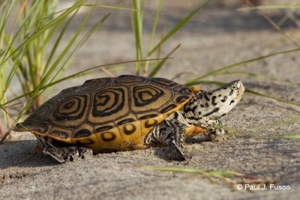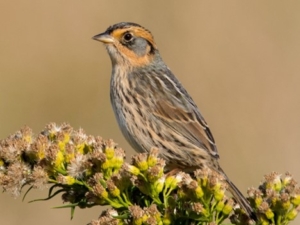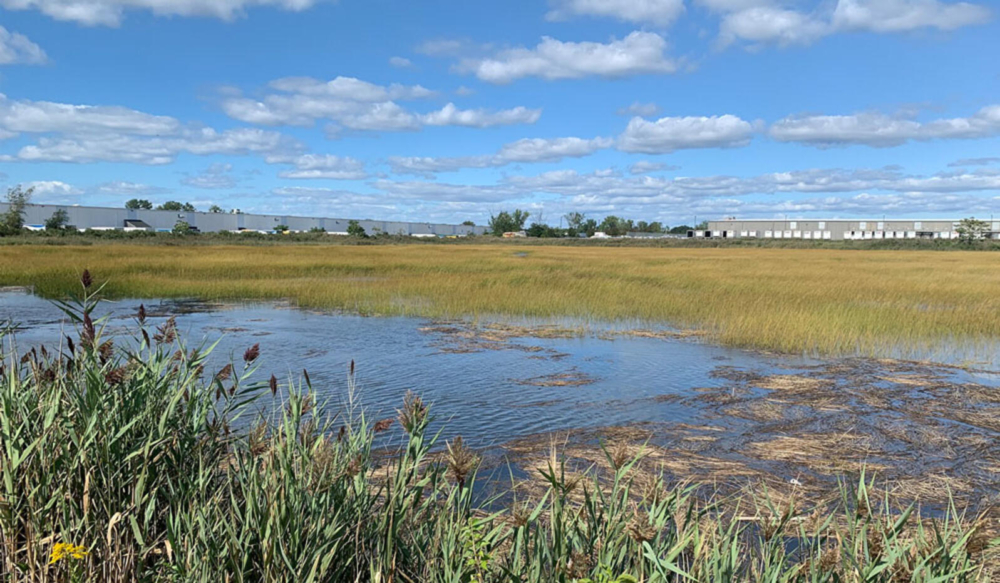Restoration of the Great Meadows Marsh
A story of land reclamation and ecosystem restoration in Stratford, Connecticut
By Mary Lawrence Young, College of William and Mary collaborator to the U.S. Fish and Wildlife Service
Great Meadows Marsh, in Stratford is among the state’s most extensive remaining salt marshes. Nonetheless, it has been drastically altered over centuries; once more than 1,400 acres, it’s now less than 700.
Portions of the marsh no longer function properly due to dredged soils brought in as fill, colonization by non-native plants, and sea-level rise. The quality of wildlife habitat on the degraded marsh has declined, and its abundant mosquitoes plague nearby residents and visitors alike.
After years of planning and fundraising, Audubon Connecticut joined with federal and state partners and the Town of Stratford to restore 34 acres of the marsh.
Construction crews removed excess soils, regraded the marsh, dug tidal channels to better drain and flush the marsh, and created higher ground for nesting saltmarsh sparrows. Volunteers, high school students, and partners planted more than 165,000 grasses and other salt-marsh plants.
Tides now regularly flood the restored area, nourishing the new plants. Partners will monitor the restoration and make small adjustments, as needed. With restoration comes increased resilience to climate change, renewed potential to support wildlife, and increased opportunities for community access
What is a salt marsh?
A salt marsh is an area where ocean and land meet that is regularly flooded and drained by seawater. Daily tides bring in nutrients that stimulate plant growth and carry out organic matter that feeds fish and other animals. Salt marshes absorb waves and storm surge like a sponge, protecting people and property.
Marsh Degredation
In 1972, environmental groups such as Protect Your Environment and the Bridgeport Conservation Commission stopped the Corps of Engineers’ plan to build a hurricane barrier that could have led to development of the entire salt marsh.
Once more than 1,400 acres in size, the marsh is now half that area, and portions no longer function properly due to addition of dredged soils, spread of non-native plants, and sea-level rise. The degraded marsh produces abundant mosquitoes that plague nearby residents and visitors alike.
Marsh Conservation
While the overall marsh has been reduced in size, it remains an excellent example of two rare habitat types in Connecticut: coastal shrubland and salt marsh. Due to its value to wildlife, more than 420 acres were added to Stewart B. McKinney National Wildlife Refuge in 1994 and thus protected from further development.
Stewart B. McKinney National Wildlife Refuge consists of 10 distinct units along the Connecticut coast, from Greenwich to Stonington, and provides habitat for many rare and endangered species. The Great Meadows Marsh Unit was named an Important Bird Area by the National Audubon Society in 2008. The refuge is part of the National Wildlife Refuge System and provides opportunities for the public to engage in wildlife-dependent recreation.
Early Implementation
After years of planning and fundraising, the $4.65-million effort to restore 34 acres of salt marsh and adjacent upland areas at Great Meadows Marsh broke ground in November 2021. Before any soil was moved, a controlled burn was performed to clear standing vegetation, especially invasive, non-native common reed (Phragmites australis). Construction crews then removed excess soil piles, or berms, along with tons of topsoil containing pieces of common reed that could resprout.
Replanting the Marsh
Once the site was cleared of common reed and modified to suit tidal flow and wildlife, volunteers, local high school students, contractors, and project partners planted more than 165,000 grasses and other non-woody plants. Species included “high marsh” grasses such as salt meadow cordgrass (Spartina patens) and spike grass (Distichlis spicata) and “low marsh” smooth cordgrass (Spartina alterniflora), as well as other species like seaside goldenrod (Solidago sempervirens), switchgrass (Panicum virgatum), and soft rush (Juncus effusus).
Looking Forward
Invasive species management, including control and removal of common reed, will continue at the site, and partners will plant additional salt marsh grasses. In 2023, partners will begin restoring another six acres of salt marsh just inland of the original project site.
Benefits to Fish and Wildlife
A healthy Great Meadows Marsh will produce more small fish and invertebrates, increasing the food supply for larger fish, birds and other animals that live in and around the marsh. More than 270 bird species, including waterfowl, shorebirds, and wading birds, use Great Meadows for foraging, nesting, and resting, or as a home during the winter. Several rare species, including saltmarsh sparrow, American kestrel, short- and long-eared owls, and seaside sparrow, rely on the marsh and surrounding area. The marsh provides important foraging and nursery habitat for horseshoe crabs, blue crabs, and fish like Atlantic silverside, Atlantic menhaden, striped bass, winter flounder, and bluefish.
Native Turtles
The fill added to the marsh in the 1950s made the terrain too steep for turtles to climb, keeping them from potential breeding habitat. During restoration, crews regraded the marsh to a more gentle slope to improve nesting habitat – and accessibility – for turtles.


 Twelve turtle species (including 4 sea turtles) occur in Connecticut. Nine of these turtles are currently on the state’s List of Endangered, Threatened and Special Concern Species.
Twelve turtle species (including 4 sea turtles) occur in Connecticut. Nine of these turtles are currently on the state’s List of Endangered, Threatened and Special Concern Species.
Stellaris flower with saltmarsh fleabane. Presently listed as endangered.
Saltmarsh Sparrow
For a slide show, maps, and photos of the restoration go to:
https://storymaps.arcgis.com/stories/24e64d93a2704efabb404abac4ecd2d3


Wonderful
What do you mean: “Now Open For Visitors”? Other than admiring the view, are there other ways for the public to enjoy the Marsh?